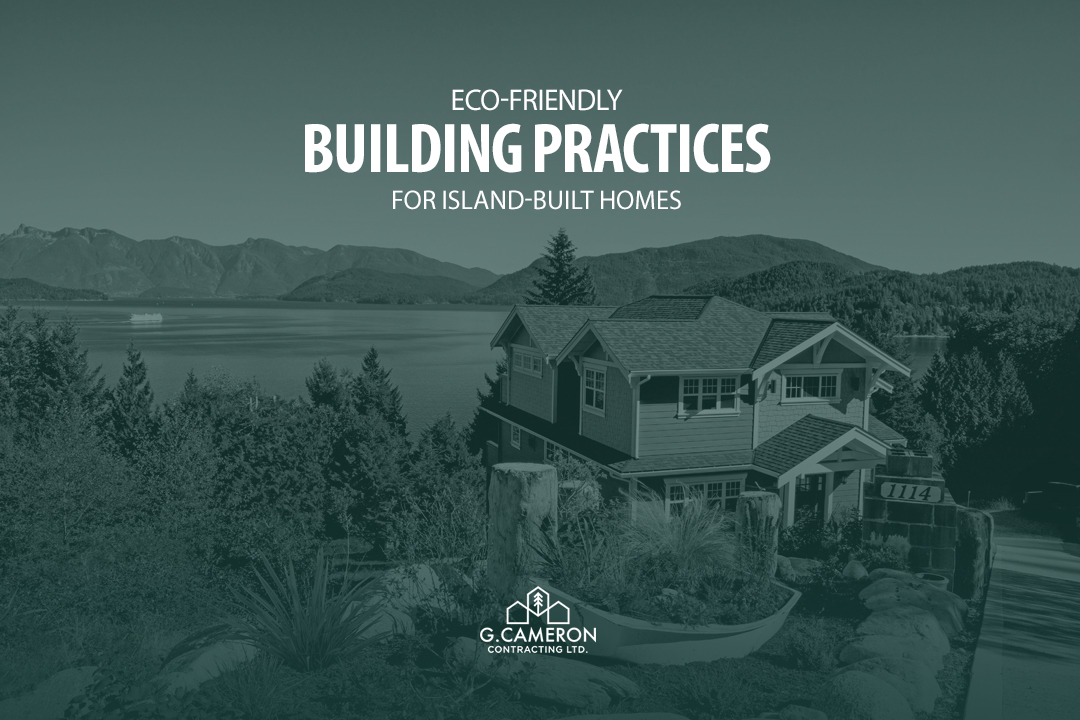Another month, another blog!
Living on the Island means we’re never far from nature, whether it’s the forest in our backyard, the ocean down the street, or the mountains on the horizon. This connection to the land is a big reason why many of us choose to live here and feel a deep responsibility to preserve the environment for future generations.
We believe that building green doesn’t mean sacrificing comfort or style. It means creating homes that are better for the planet and built to last in our unique coastal climate.
We’ve put together a few key building practices that can make your new Island home more eco-friendly, helping protect the natural beauty that surrounds it.
Let’s dive in!
SMART PLANNING
A sustainable home starts long before the first nail is hammered; it starts with smart planning.
Select a site that reduces disruption to the natural landscape, avoids sensitive ecosystems, and minimizes excavation. Also, consider your home’s orientation to take advantage of natural sunlight, shade, and wind patterns. This decreases the need for artificial lighting, heating, and cooling.
The more thoughtfully you plan, the better your home will perform in the long run.
SUSTAINABLE MATERIALS
Consider using materials that are long-lasting, responsibly sourced, and suitable for the Island’s climate.
- Locally Sourced: Choose materials that are already available on the Island to reduce transportation emissions and support the local economy.
- Renewable Resources: Opt for materials that regenerate quickly and have a minimal environmental impact, like bamboo and sustainably harvested wood.
- Recycled Materials: Use reclaimed wood, recycled plastics, and other repurposed materials to give existing resources a second life.
- Natural Materials: Incorporate durable, biodegradable, and non-toxic materials, such as natural stone and wool insulation, for a healthier home environment.
Using sustainable materials that last means fewer repairs down the line and less waste ending up in landfills.
WATER CONSERVATION
Water may seem abundant on the West Coast, but conservation still matters.
Low-flow faucets, showerheads, and dual-flush toilets can significantly reduce water use without compromising performance. Rainwater harvesting systems are also great for collecting and storing rainwater for non-potable uses, like toilet flushing and garden irrigation.
By making a few mindful choices, you can reduce your environmental impact and build a more eco-friendly home.
WASTE MANAGEMENT
Construction projects can generate a surprising amount of waste, but with a bit of planning, much of it can be diverted from the landfill.
When possible, reuse or repurpose leftover materials, such as wood offcuts, natural stone, and fixtures. You can also donate usable items to local building reuse centres or community groups, where they can be used instead of ending up in the trash.
Responsibly taking care of waste is one of the easiest ways to build greener without changing your design plans.
ENERGY-EFFICIENT SYSTEMS
Lighting, heating, and cooling your home accounts for a large portion of your energy consumption.
Reduce your reliance on the electrical grid by installing solar panels, which harness renewable energy to power your home. Opt for LED lighting, as it uses less energy and lasts longer than traditional bulbs. Install a heat pump for more efficient temperature control, and add a programmable thermostat to further optimize energy use.
Energy-efficient systems can lower not only your carbon footprint, but your utility bill as well.
If you’re thinking about building or renovating on the Island, eco-friendly practices are the best way to protect what makes this place so special. Luckily, we can help with that – contact us here to get your project started!
Stay connected with us on Instagram, Facebook, and LinkedIn.
Thanks for reading, and here’s to building a greener future together!

